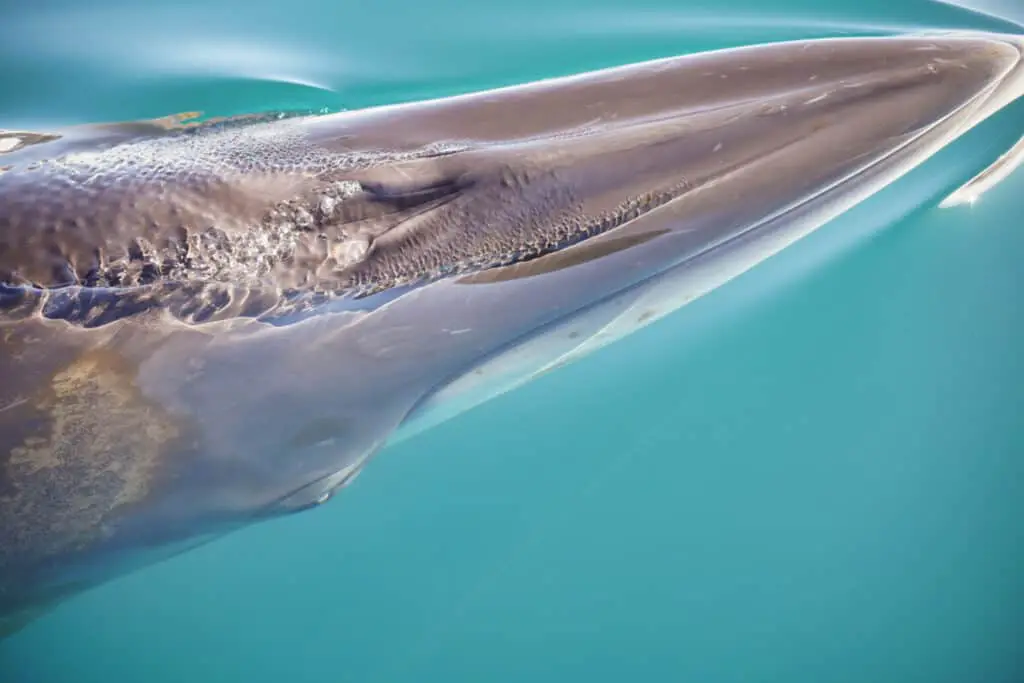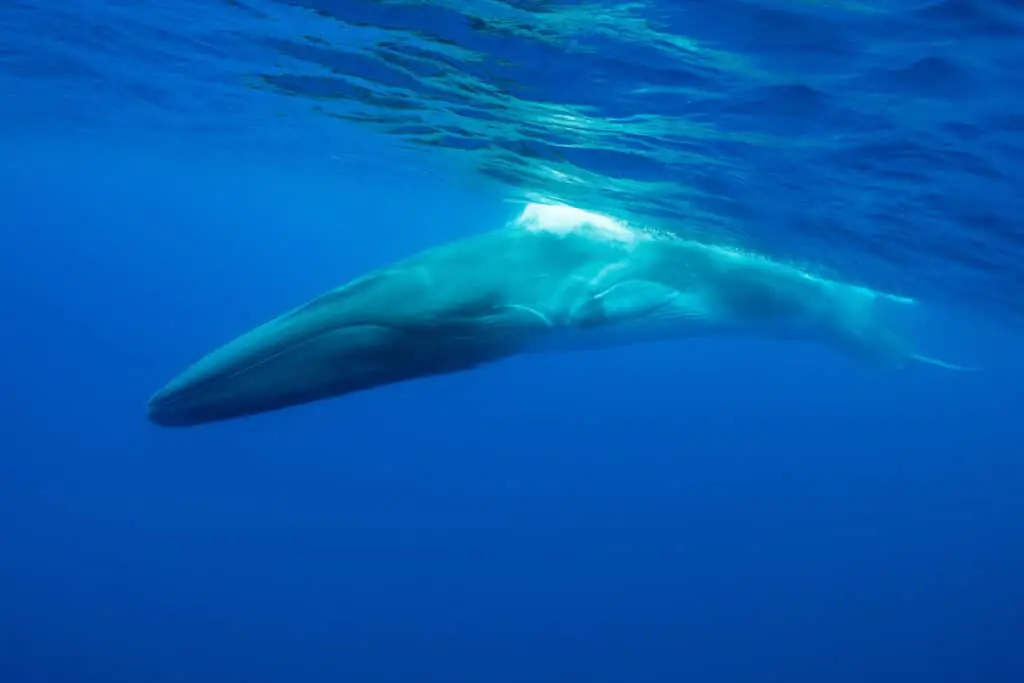The Fin Whale, also known as the razorback whale or common rorqual, is a large marine mammal found in oceans worldwide.
It is the second-largest animal on earth after its relative, the Blue Whale. These whales can grow up to 85 feet long and weigh over 74 tons. Despite their size, these animals are swift swimmers and can reach speeds of up to 23 miles per hour.
They are known for their unique asymmetrical coloration with white on the right side of the lower jaw and dark gray or black on the left.
Unfortunately, like many other species of whales, they have been heavily hunted for their meat and oil since the early 20th century.
As a result, they have experienced significant population declines in some regions but remain listed as an endangered species by multiple conservation organizations around the world.

Physical Characteristics And Size
Despite being the second-largest animal on earth, fin whales possess a sleek and slender physique.
They have long and narrow heads that slope into their bodies, which are torpedo-shaped with a tapered tail.
Their skin is dark grey or brownish-black and has distinctive asymmetrical markings on their lower jaw that differ from whale to whale.
The largest recorded length of an adult male fin whale was 27 meters (88 feet) while females were slightly larger at around 27.5 meters (90 feet).
Despite its massive size, this species can swim up to speeds of 37 kph (23 mph).
Behavioral patterns of fin whales are known for their solitary nature; however, they also form small groups called pods during migration or feeding periods.
These pods typically consist of two to seven individuals but may increase in number when there is abundant food supply.
Fin whales are baleen feeders who filter krill and other planktonic organisms through their large mouth openings as they glide through the water column with jaws open wide.
They consume enormous amounts of prey daily – approximately 1-2 tons per day during peak feeding season – making them one of the most efficient predators in the ocean today.
Worldwide Distribution And Habitat
The fin whale is found in all major oceans of the world, from polar to tropical waters. They are known for their extensive migration patterns, which can cover up to 20,000 kilometers per year. These migrations depend on the availability of food and water temperature changes.
During summer months, they often migrate towards high latitudes where food sources such as krill and small fish abound. In winter months, they move back towards equatorial regions.
Feeding behavior of fin whales varies depending on location and season. They primarily feed on schooling fish species such as herring, mackerel, and sand eels during northern hemisphere summers while switching over to krill in colder seasons when these crustaceans become abundant at higher latitudes.
They use a unique feeding mechanism called lunge-feeding where they engulf large amounts of prey by opening their mouths wide like a parachute before closing it rapidly thereby pushing out most of the water through their baleen plates leaving only the prey behind for consumption. This method allows them to devour enormous quantities of food quickly making them one of the largest animals that have ever lived.
Gray Whales’ Predators Revealed: Unmasking the Threats
Unique Coloration And Asymmetry
The worldwide distribution and habitat of fin whales are vast, as they can be found in all major oceans except for the polar seas. They prefer temperate to polar waters and are often seen near the surface, feeding on krill and small schooling fish. These whales have been known to travel long distances during migration periods and are capable of diving to depths of up to 230 meters.
Fin whales are easily recognizable due to their unique coloration patterns. Their bodies are mostly dark grey or black with a white underside, but what sets them apart from other whale species is their asymmetrical pigmentation around the mouth area. This adaptation may have evolved as a way to camouflage themselves while hunting prey or to communicate with others of their kind. Additionally, these whales possess specialized throat grooves that allow them to expand their mouths when feeding, which is another evolutionary advantage that aids in catching more food at once.
The role of fin whales in marine ecosystems
Conservation efforts for protecting this endangered species
Historical significance and cultural importance of fin whales
Comparison between baleen whale species
Unique vocalizations and communication methods among fin whales
Overall, the distinctive coloration patterns and evolutionary adaptations present in fin whales make them an intriguing subject for study. As we continue to learn more about these magnificent creatures, it is important that we also prioritize conservation efforts to protect them from further decline in population numbers.
Unveiling the Majestic Size of Whales
Threats To The Species
The fin whale is currently facing a number of threats that are putting the species at risk.
One major threat to their survival comes from overfishing, which has led to a decline in the availability of krill and other small fish that make up much of the diet for these animals. As the demand for seafood continues to grow, fishing fleets often catch more than they need, leading to a depletion of resources and ultimately harming populations of marine mammals like the fin whale.
Another significant threat to fin whales is pollution, particularly plastic waste that can become entangled in their mouths or digestive systems. This can cause serious health problems such as infections or blockages, making it difficult for them to feed and survive.
Additionally, oil spills and chemical pollutants can also have devastating effects on these creatures by contaminating their food sources and damaging their respiratory systems.
It is clear that immediate action must be taken to address these threats if we hope to prevent further harm to this majestic species.
Conservation Efforts And Endangered Status
Efforts to conserve fin whale populations have been implemented in recent years due to their endangered status. The efficiency of these conservation measures, however, remains uncertain.
Whaling is the biggest threat facing this species and has led to a significant decrease in population size over the past century. In response, various international agreements such as the International Convention for the Regulation of Whaling (ICRW) were established to protect them from commercial whaling activities. Moreover, some countries have also prohibited hunting or trading any parts of this species.
Despite these efforts, public awareness regarding the threats that fin whales face remains low. This lack of knowledge poses a challenge for conservationists who seek to raise awareness about their plight and mobilize support for conservation initiatives.
Increased outreach programs are necessary not only to educate people about how important it is to save these whales but also to foster active participation in conservation efforts at both local and global levels. Overall, more research needs to be done on effective methods of raising public awareness so that we can ensure a brighter future for fin whales and other threatened marine species alike.

Role In Marine Ecosystems And Importance For Biodiversity
Conservation efforts for the fin whale have been implemented globally due to their endangered status. Despite this, more needs to be done to protect these animals from threats such as ship strikes and entanglement in fishing gear.
The International Whaling Commission banned commercial whaling of all large whales, including the fin whale, in 1986; however, Iceland and Japan continue to hunt them under controversial research permits. With a slow reproductive rate and low population numbers, it is crucial that steps are taken to ensure the survival of these magnificent creatures.
The importance of the fin whale extends beyond its conservation status. As one of the largest predators in the ocean, they play an essential role in marine food webs by feeding on krill and small fish. This consumption helps regulate populations of prey species and maintain ecological balance within oceans.
Additionally, when dead or dying, fin whales provide sustenance for other organisms such as scavenging sharks and hagfish. Overall, understanding their ecological significance highlights the need for continued protection and conservation efforts for these majestic animals.
Conclusion
The fin whale, scientifically known as Balaenoptera physalus, is a remarkable marine mammal that inhabits all of the world’s oceans. This species belongs to the family of baleen whales and is recognized for its streamlined body shape, which can reach up to 27 meters in length and weigh over 70 tonnes. Furthermore, it has unique coloration with asymmetrical markings on its lower jaw and belly.
Despite the fin whale’s impressive size and strength, this species faces various threats from human activities such as hunting, entanglement in fishing gear, pollution, climate change, and habitat loss. As a result of these factors, the International Union for Conservation of Nature (IUCN) listed the fin whale as endangered.
However, conservation efforts have been put into place by governments and non-governmental organizations worldwide to protect this magnificent creature from extinction.
In conclusion, the fin whale plays an essential role in maintaining biodiversity within marine ecosystems through nutrient cycling and regulating food webs. It is crucial that we recognize our impact on their survival and take action towards preserving their habitats for future generations.
As they say: ‘Don’t judge a book by its cover,’ let us not overlook the significance of these gentle giants due to their massive size or unique features but acknowledge them as keystone species necessary for healthy oceanic environments.

